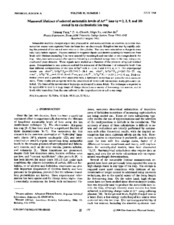| dc.creator | Yang, L. S. | |
| dc.creator | Church, David A. | |
| dc.creator | Tu, S. G. | |
| dc.creator | Jin, J. | |
| dc.date.accessioned | 2011-09-08T21:35:45Z | |
| dc.date.available | 2011-09-08T21:35:45Z | |
| dc.date.issued | 1994 | |
| dc.identifier.citation | L. S. Yang, David A. Church, S. G. Tu and J. Jin. Phys.Rev.A 50 177-185 1994. "Copyright (1994) by the American Physical Society." | en |
| dc.identifier.uri | http://dx.doi.org/10.1103/PhysRevA.50.177 | |
| dc.identifier.uri | https://hdl.handle.net/1969.1/126530 | |
| dc.description | Journals published by the American Physical Society can be found at http://publish.aps.org/ | en |
| dc.description.abstract | Metastable multiply charged argon ions produced in, and extracted from, an electron cyclotron resonance ion source were captured from the beam into an electrostatic (Kingdon) ion trap by rapidly pulsing the potential of the central wire relative to the cylinder. The ions were selected on a charge-to-mass ratio basis before capture. Photons emitted in magnetic-dipole and electric-quadrupole transitions from levels with lifetimes exceeding 5 ms were selected by wavelength and recorded vs ion storage time in the trap. Also, ions were counted after ejection following a preselected storage time in the trap, using a microchannel plate detector. These signals were studied as a function of the pressure of typical residual gases. Extrapolation to zero pressure enabled the extraction of the lifetimes tau of metastable levels from four different configurations of the type ns2np(k) with n = 2 or 3 and k = 3, 4, or 5. Our experimental results are tau(Ar2+, 3s(2)3p4 S-1(0)) = 159.7 +/- 9.7-38.4 ms, tau(Ar3+, 3s(2)3p3 P-2(3/2)) = 243 +/- 73-79 ms, tau(Ar9+, 2s(2)2p5 P-2(1/2)) = 8.53 +/- 0.24-0.17 ms, and tau(Ar10+, 2s(2)2p4 P-3(1)) = 14.8 +/- 1.1-0.48 ms. Both statistical errors and a possible error associated with a systematic correction are given for each measurement. These results are compared with the predictions of theoretical calculations, many previously untested. The basis of the measurement technique is discussed in some detail. The technique is expected to be applicable to ions in a large range of charge states from a variety of low-energy ion sources, and to levels with transitions from the near-infrared to the deep-ultraviolet or soft-x-ray range. | en |
| dc.language.iso | en | |
| dc.publisher | American Physical Society | |
| dc.subject | HIGHLY-CHARGED IONS | en |
| dc.subject | TRANSITION-PROBABILITIES | en |
| dc.subject | RADIATIVE LIFETIME | en |
| dc.subject | FORBIDDEN LINES | en |
| dc.subject | CONFIGURATION | en |
| dc.subject | STATE | en |
| dc.subject | 3P4 | en |
| dc.subject | N+ | en |
| dc.subject | Optics | en |
| dc.subject | Physics, Atomic, Molecular and Chemical | en |
| dc.title | Measured Lifetimes of Selected Metastable Levels of Arq+ Ions (Q=2, 3, 9, and 10) Stored in an Electrostatic Ion-Trap | en |
| dc.type | Article | en |
| local.department | Physics and Astronomy | en |


